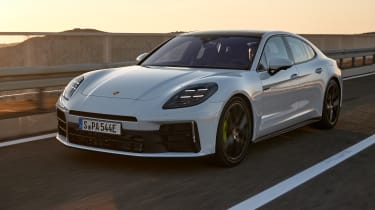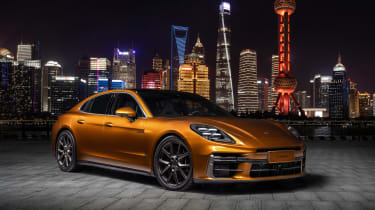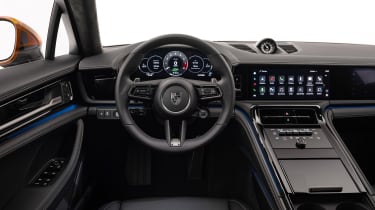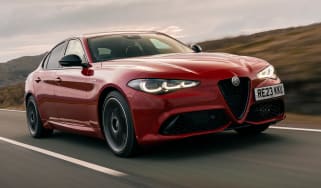New 2024 Porsche Panamera: prices, specs and first deliveries
Porsche’s exec-express has been given a 2024 makeover, with a host of Taycan-inspired design and technology upgrades
You would be forgiven for thinking the Panamera is nearing retirement age in the wake of its ultra advanced battery powered stablemate, but quite the opposite is true. The high end luxury car market still has an appetite for petrol models, allowing Porsche to update the Panamera to bring it back into the spotlight for 2024. Following the initial launch of Turbo models last year, details on middling 4 and 4S E-Hybrid models have now surfaced, set to be the most popular of the lineup. First deliveries will commence in March 2024.
Combining a 2.9-litre twin-turbocharged V6 with an uprated 187bhp electric motor, these hot plug-in hybrid models are now capable of a 60-mile pure electric range thanks to a larger 25.9kWh battery pack. Output now stands at 463bhp and 479lb ft of torque for the 4 E-Hybrid, rising to 535bhp and 553lb ft for the more potent 4S – a brisk 3.7sec 0-62mph time is quoted for the latter, rising by four tenths for the 4. Porsche has now axed the Sport Turismo body shape in Europe for this generation making it saloon-only, with prices starting from £90,300 and £102,100 for the 4 and 4S E-Hybrid respectively.
Core to the overall upgrades are to make the Panamera a more engaging yet more comfortable car to drive, something it already did better than its rivals, while drawing extra performance and efficiency from a new lineup of revised powertrains. A host of cosmetic and interior upgrades have been applied too, all of which take inspiration from the Taycan.
Its overall look is broadly familiar, but Porsche has gone one or two steps beyond what normally constitutes a facelift. There’s a new front bumper with redesigned cooling vent openings and an additional air inlet above the number plate, as well as new matrix LED headlights as standard (HD matrix LED units are optional). The Panamera’s distinctive vertical side vent behind the front wheels has been flared out slightly as part of the facelift, too.
There are more bodywork changes made to the rear of the car, where there’s a new quarter panel pressing that integrates with a subtly reprofiled glasshouse. The LED rear light bar evokes that of the Taycan, with a new lower valance completing what is a fairly comprehensive redesign.
The key changes, however, are under the skin. The same core powertrain options are provided, with 2.9-litre turbocharged V6 models positioned below E-Hybrid plug-in hybrids, but each has been revised for improved power and performance. Modifications to the ignition timing, fuel flow rate and turbo boost pressure raise the base car’s outputs to 348bhp and 369lb ft – this propels the Panamera from 0-62mph in 5.2sec in rear-wheel drive form, with the Panamera 4 shortening that by 0.4sec.
A total of four plug-in models will be offered, with the Turbo E-Hybrid topping the range. Where lesser E-Hybrids use the aforementioned V6 engine, the Turbo E-Hybrid retains a 4-litre twin-turbo V8. This combines with an uprated 255bhp electric motor integrated into the powertrain’s eight-speed PDK gearbox to deliver 671bhp and 686lb ft, good enough for a 3.2sec 0-62mph time and a 196mph top speed.
Thanks to a larger 25.9kWh battery, plug-in hybrid versions also gain extra electric range, with the Turbo E-Hybrid achieving up to 56 miles from a full battery. A new 11kW onboard charger also enables quicker top ups.
The outgoing car’s two-chamber air suspension system has been modified for the facelift, with the standard PASM adaptive dampers now adjusting separately for compression and rebound for better ride quality and control. Rear-wheel steering can be fitted at extra cost, and Porsche has developed a new Active Ride suspension system to take the Panamera’s dynamics to another level. Specify this and the standard air springs are swapped for single-chamber units, with dampers linked up to a hydraulic pump to control the flow of fluid at each corner. This allows for rapid, electronically-controlled changes in support and compliance across all four wheels, keeping the body flat under high loads while soaking up road imperfections where required.
Inside, the Panamera follows the same design direction as the Taycan (and the recently facelifted Cayenne). The gear selector is now a small switch off to the side of the steering wheel, which frees up the centre console to house climate control switches and a larger storage bin. The previous analogue dial pack has also been replaced by a fully digital curved panel, and the Panamera can now be specified with a 10.9-inch passenger display mounted next to the main 12.3-inch touchscreen. A directional filter blocks it from the driver’s view, giving passengers access to video streaming services while on the move.
The revised Panamera is on sale now, starting at £79,500 for the base car and rising to £82,500 and £141,400 for the Panamera 4 and Turbo E-Hybrid respectively. First deliveries are scheduled for March 2024.









